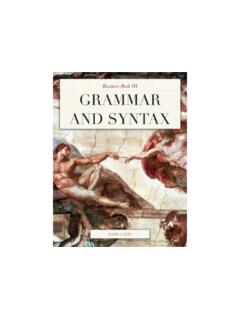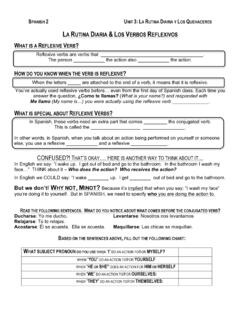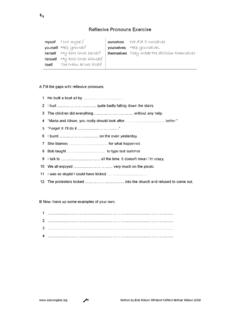Transcription of NOUNS, PRONOUNS, AND ADJECTIVES
1 NOUNS, pronouns , AND ADJECTIVESR esource Book IKMHS LATINC hapter 1 Nouns are listed in the dictionary with a very specific vocabulary entry. It includes the nominative singular form, the genitive singular, and the gender, as well as anything that is unusual or specific to that noun. Nouns are grouped into five declensions. Each declension is identified by the ending on the genitive singular form. Each declension has its own group of endings. The endings are added to the stem, which is found by dropping the ending from the genitive are listed in the dictionary with a very specific vocabu-lary entry.
2 It includes the nominative singular form, the geni-tive singular, and the gender, as well as anything that is un-usual or specific to that noun. Examples: puer, puer , m. boy urbs, urbis, genitive plural urbium, f. city vis, ---, f. strength, force, power, violence canis, canis, dogNouns are grouped into five declensions. Each declension is identified by the ending on the genitive singular form. Each declension has its own group of endings. The endings are added to the stem, which is found by dropping the ending from the genitive 1 The Latin NounThe first declension is identified by the -ae ending on the genitive singular form.
3 Most, but not all, first declension nouns are feminine. Example: femina, feminae, f. woman stem: femin-SINGULARPLURALNom. feminafeminaeGen. feminaefemin rumDat. feminaefemin sAcc. feminamfemin sAbl. femin femin sVoc. feminafeminae3 SECTION 2 The First DeclensionSINGULARPLURALNom. -a-aeGen. -ae- rumDat. -ae- sAcc. -am- sAbl. - - sVoc. -a-aeThe second declension is identified by the ending - on the genitive singular form. Most second declension nouns are ei-ther masculine or neuter. Masculine and neuter second de-clension nouns have their own endings.
4 SINGULARPLURALNom. -us (---) *- Gen. - - rumDat. - - sAcc. -um- sAbl. - - sVoc. -e (---)**- * Most second declension nouns have a nominative singular form that ends in -us. Some have a variable form, often end-ing in an er. ** When a second declension noun has a nominative form that ends in -us, the vocative ending is -e. When it has a vari-able form, the vocative ending is identical to the nominative. For second declension nouns that have an -i- before the -us ending, that ending contracts with the -e, giving a vocative ending of - .MasculineExample: servus, - , m.
5 Stem: serv-SINGULARPLURALNom. servusserv Gen. serv serv rumDat. serv serv sAcc. servumserv sAbl. serv serv sVoc. serveserv 4 SECTION 3 The Second DeclensionExample: raedarius, - , m. stem: raedari-SINGULARPLURALNom. raedariusraedari Gen. raedari raedari rumDat. raedari raedari sAcc. raedariumraedari sAbl. raedari raedari sVoc. raedar raedari SINGULARPLURALNom. puerpuer Gen. puer puer rumDat. puer puer sAcc. puerumpuer sAbl. puer puer sVoc. puerpuer FeminineSINGULARPLURALNom. hortushort Gen. hort hort rumDat. hort hort sAcc. hortumhort sAbl.
6 Hort hort sVoc. hortehort 5 Neuter Neuter nouns of the second declension use slightly differ-ent endings from those of masculine and feminine nouns. SINGULARPLURALNom. -um-aGen. - - rumDat. - - sAcc. -um-aAbl. - - sVoc. -um-aThere are two helpful hints to remember with neuter nouns: nominative, accusative, and vocative endings are al-ways the same. nominative, accusative, and vocative plural endings always end with -a, regardless of the declension. Example: baculum, - , n. - stick stem: bacul bacul rumDat. bacul bacul sAcc. baculumbaculaAbl.
7 Bacul bacul sVoc. baculumbaculaThird declension nouns are nouns that share an -is ending in the genitive singular. All genders share this -is ending in the genitive singular. When declining a third declension noun, the same endings are used for masculine and feminine nouns. As with the second declension, a slightly different paradigm is used for the neuter gender. In the third declension, the nominative and vocative forms are always is no one consistent ending for the nominative singular form. The nominative singular for third declension should be memorized as a and FeminineExample: pater, patris, m.
8 Stem: sGen. patrispatrumDat. patr patribusAcc. patrempatr sAbl. patrepatribus7 SECTION 4 The Third sGen. -is-umDat. - -ibusAcc. -em- sAbl. -e-ibus Neuter Neuter nouns differ from masculine and feminine nouns in two ways. In the accusative singular, instead of having the -em ending, they once again have the variable. In the nomina-tive and accusative plural endings, they have an -a instead of - s. Example: tempus, temp ris, n. stem: temp raGen. temp ristemp rumDat. temp r temp ribusAcc. tempustemp raAbl. temp retemp ribusThird Declension I-stem NounsThere is a subcategory of third declension nouns called I-stem nouns.
9 These nouns have slightly different endings. They actually resemble the endings of third declension adjec-tives. These nouns will be identified by the vocabulary entry. Dictionaries and books will include either (-ium) or the full genitive plural form written out. SINGULAR (N.)PLURAL (N.) s (-ia)Gen. -is-iumDat. - -ibusAcc. -em- s (-ia)Abl. -e ( )-ibusExample: glis, gliris, (-ium) m. stem: glir-SINGULAR (N.)PLURAL (N.) sGen. glirisgliriumDat. glir gliribusAcc. gliremglir sAbl. -is-umDat. - -ibusAcc. -em-aAbl. -e-ibusExample: mare, maris, (-ium) n.
10 Stem: mar-SINGULAR (N.)PLURAL (N.) marismariumDat. mar maribusAcc. maremariaAbl. mar maribus9Fo u r t h D e c l e n s i o n n o u n s c a n b e i d e n t i f i e d by t h e - s e n d i n g on the genitive singular form. There are two sets of endings for the fourth declension: one for masculine and feminine nouns and one for neuter nouns. Masculine and sGen. - s-uumDat. -u -ibusAcc. -um- sAbl. - s-ibusExample: manus, man s, f. stem: sGen. man smanuumDat. manu manibusAcc. manumman sAbl. man smanibus10 SECTION 5 The Fourth DeclensionNeuterThere are three neuter fourth declension nouns: corn , corn s, n.








